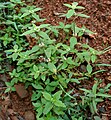
Psidium is a genus of trees and shrubs in the family Myrtaceae. It is native to warmer parts of the Western Hemisphere. Many of the species bear edible fruits, and for this reason several are cultivated commercially. The most popularly cultivated species is the common guava, Psidium guajava.
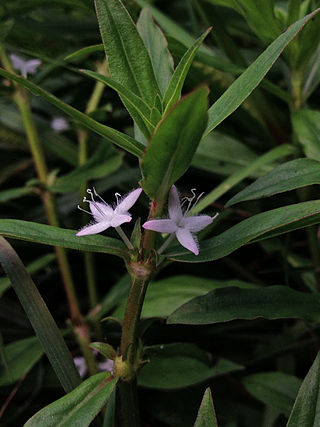
Diodia is a genus of flowering plants in the family Rubiaceae. It was described by Carl Linnaeus in 1753. The genus is found from southern and eastern United States, South America, Central America, Mexico, the West Indies and tropical Africa.
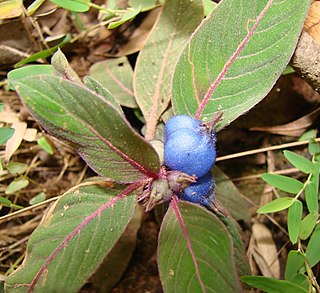
Coccocypselum is a genus of flowering plants in the family Rubiaceae. It is native to Mexico, Central America, the West Indies and South America. All species of the genus Coccocypselum are herbaceous with fleshy, blue or purple fruits, and 4-petaled flowers.

Hexasepalum teres is a species of flowering plant in the coffee family known by the common names poorjoe and rough buttonweed. This annual plant is native to Mexico, Central America, South America, the West Indies and the United States from California to Florida and from Kansas to Massachusetts. The species is also naturalized in the Netherlands, the Canary Islands, Western Africa, Angola, China, Japan and Korea, India, and Madagascar.

Lasiacis (smallcane) is a genus of Neotropical plants in the grass family, found in the Americas from Mexico and Florida south to Argentina.

Sphagneticola is a genus of flowering plants in the family Asteraceae. Creeping-oxeye is a common name for plants in this genus.
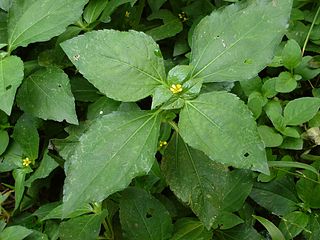
Synedrella is a genus of flowering plants in the family Asteraceae.

Ardisia escallonioides, the Island marlberry, is a plant species native to the West Indies and neighboring areas. It has been reported from Barbados, Bermuda, the Dominican Republic, Cuba, Mexico, Belize, Guatemala and Florida.

Spermacoce remota, the woodland false buttonweed, is a species of plant in the Rubiaceae. It is native to the southeastern United States, West Indies, Mexico, Central America and South America. It is naturalized in Taiwan, Southeast Asia, China (Guangdong), India, Sri Lanka, New Guinea, Mauritius and many other oceanic islands.
Spermacoce neoterminalis, the Everglades Key false buttonweed, is a species of plant in the Rubiaceae. It is endemic to southern Florida, from the Everglades as far north as Lake Okeechobee.
Spermacoce ovalifolia, the broadleaf false buttonweed, is a species of plants in the Rubiaceae. It is native to Mexico, Central America, parts of the Caribbean, and South America.
Spermacoce brachysepala, the West Indian false buttonweed, is a plant species in the Rubiaceae. It is native to Puerto Rico, Haiti and the Dominican Republic.
Spermacoce keyensis, the Florida false buttonweed, is a species of plants in the family Rubiaceae, first discovered in the Florida Keys. It is found in southern Florida, Bahamas, and the extreme southern tip of Texas.

Spermacoce alata, the winged false buttonweed, is a species of plant in the family Rubiaceae. It is widespread across the warmer parts of the Western Hemisphere and naturalized in many other parts of the world.
Spermacoce glabra, smooth false buttonweed, is a New World species of plants in the coffee family.

Spermacoce prostrata is a species of plants in the Rubiaceae. In the United States, it is widespread in Florida, with a few isolated populations in Alabama and Mississippi. The species is native to Mexico, Central America, the Caribbean (Bahamas, Cuba, Hispaniola, Puerto Rico, Trinidad, Turks & Caicos, the Lesser Antilles, and the Dutch and Venezuelan Antilles. It is also widespread in South America, found in every country except Chile. The species is reportedly naturalized in Hawaii, China, Japan, Taiwan, Sri Lanka, Thailand and Java.
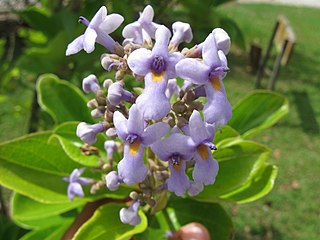
Cornutia is a genus of plants in the family Lamiaceae, first described in 1753. Species in this genus are native to tropical parts of the Western Hemisphere, including southern Mexico, Central America, the West Indies, and northern South America.

Echites is a genus of flowering plants in the family Apocynaceae, first described as a genus in 1756. It is primarily native to Mexico, Central America, the West Indies, and the US State of Florida.

Prunus myrtifolia, called the West Indies cherry or myrtle laurel cherry, is a New World species of shrubs in the family Rosaceae.
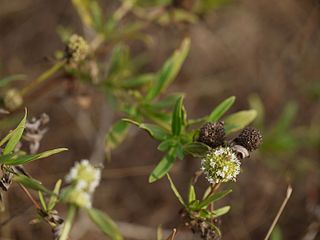
Spermacoce verticillata, the shrubby false buttonweed, is a species of plant in the family Rubiaceae.


















